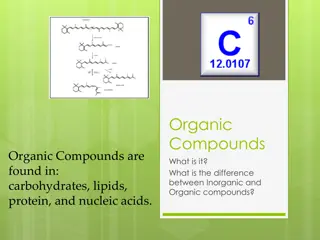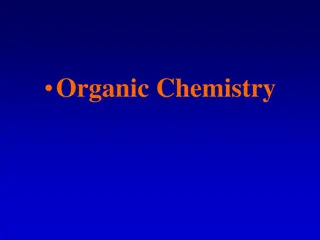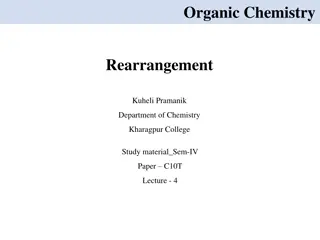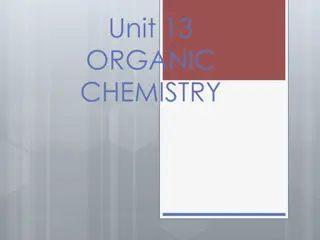Understanding Organic Chemistry: Introduction to Carbon Compounds
Organic chemistry is the study of carbon compounds, with carbon's unique electronic structure allowing for a vast array of compounds. This field touches many aspects of life, from medicines to polymers. The nucleus of an atom, comprising protons and neutrons, is surrounded by electrons occupying orbitals. Different orbital shapes like s, p, and d play crucial roles in organic and biological chemistry.
Download Presentation

Please find below an Image/Link to download the presentation.
The content on the website is provided AS IS for your information and personal use only. It may not be sold, licensed, or shared on other websites without obtaining consent from the author. Download presentation by click this link. If you encounter any issues during the download, it is possible that the publisher has removed the file from their server.
E N D
Presentation Transcript
OrganicChemistry (I) Introduction Dr. AyadKareem Introduction Dr. Ayad Kareem Department Pharmacy, Al-Mustansiriyah University 2017-2018. of Pharmaceutical Chemistry, Collage of References Text Books: 1. John McMurry "Organic Chemistry" 9th Edition Cengage Learning, USA (2016). 2. R.T. Morrison, R.N. Boyd and S.K. Bhattacharjee "Organic Chemistry" 7th Edition Pearson Education Inc. India (2011). Organic chemistry, then, is the study of carbon compounds. But why is carbon special? Why, of the more than 50 million presently known chemical compounds, do most of them contain carbon? The answers to these questions come from carbon s electronic structure and its consequent position in the periodic table (Figure 1-1). As a group 4A element, carbon can share four valence electrons and form four strong covalent bonds. Furthermore, carbon atoms can bond to one another, forming long chains and rings. Carbon, alone of all elements, is able to form an immense diversity of compounds, from the simple methane, with one carbon atom, to the staggeringly complex DNA, which can have more than 100 million carbons. Figure 1-1 The position of carbon in the periodic table. Other elements commonly found in organic compounds are shown in the colors typically used to represent them. Of course, not all carbon compounds are derived from living organisms. Modern chemists have developed a remarkably sophisticated ability to design and synthesize new organic compounds in the laboratory medicines, dyes, polymers, and a host of other substances. Organic chemistry touches the lives of everyone; its study can be a fascinating undertaking. 1
OrganicChemistry (I) Introduction Dr. AyadKareem Atomic Structure: The Nucleus As you probably know from your general chemistry course, an atom consists of a dense, positively charged nucleus surrounded at a relatively large distance by negatively charged electrons (Figure 1-2). The nucleus consists of subatomic particles called protons, which are positively charged, and neutrons, which are electrically neutral. Because an atom is neutral overall, the number of positive protons in the nucleus and the number of negative electrons surrounding the nucleus are the same. Figure 1-2 A schematic view of an atom. The dense, positively charged nucleus contains most of the atom s mass and is surrounded by negatively charged electrons. The three dimensional view on the right shows calculated electron-density surfaces. Electron density increases steadily toward the nucleus and is 40 times greater at the blue solid surface than at the gray mesh surface. Atomic Structure: Orbitals An orbital describes the volume of space around a nucleus that an electron is most likely to occupy. You might therefore think of an orbital as looking like a photograph of the electron taken at a slow shutter speed. In such a photo, the orbital would appear as a blurry cloud, indicating the region of space where the electron has been. This electron cloud doesn t have a sharp boundary, but for practical purposes we can set its limits by saying that an orbital represents the space where an electron spends 90% to 95% of its time. What do orbitals look like? There are four different kinds of orbitals, denoted s, p, d, and f, each with a different shape. Of the four, we ll be concerned primarily with s and p orbitals because these are the most common in organic and biological chemistry. An s orbital is spherical, with the nucleus at its center; a p orbital is dumbbell-shaped; and four of the five d orbitals are clover leaf-shaped, as shown in Figure 1-3. The fifth d orbital is shaped like an elongated dumbbell with a doughnut around its middle. The orbitals in an atom are organized into different electron shells, centered on the nucleus and having successively larger size and energy. Different shells contain different numbers and kinds of orbitals, and each orbital within a shell can be occupied by two electrons. 2
OrganicChemistry (I) Introduction Dr. AyadKareem An s orbital A p orbital A d orbital Figure 1-3 Representations of s, p, and d orbitals. An s orbital is spherical, a p orbital is dumbbell shaped, and four of the five d orbitals are cloverleaf-shaped. Different lobes of p and d orbitals are often drawn for convenience as teardrops, but their actual shape is more like that of a doorknob, as indicated. The first shell contains only a single s orbital, denoted 1s, and thus holds only 2 electrons. The second shell contains one 2s orbital and three 2p orbitals and thus holds a total of 8 electrons. The third shell contains a 3s orbital, three 3p orbitals, and five 3d orbitals, for a total capacity of 18 electrons. These orbital groupings and their energy levels are shown in Figure 1-4. Figure 1-4 The energy levels of electrons in an atom. The first shell holds a maximum of 2 electrons in one 1s orbital; the second shell holds a maximum of 8 electrons in one 2s and three 2p orbitals; the third shell holds a maximum of 18 electrons in one 3s, three 3p, and five 3d orbitals; and so on. The two electrons in each orbital are represented by up and down arrows, hg. Althoughnot shown, the energy level of the 4s orbital falls between 3p and 3d. The three different p orbitals within a given shell are oriented in space along mutually perpendicular directions, denoted px, py, and pz. As shown in Figure 1-5, the two lobes of each p orbital are separated by a region of zero electron density called a node. Furthermore, the two orbital regions separated by the node have different algebraic signs, 1 and 2, in the wave function, as represented by the different colors in Figure 1-5. We ll see that these algebraic signs for different orbital lobes have important consequences with respect to chemical bonding and chemical reactivity. 3
OrganicChemistry (I) Introduction Dr. AyadKareem Figure 1-5 Shapes of the 2p orbitals. Each of the three mutually perpendicular, dumbbell shaped orbitals has two lobes separated by a node. The two lobes have different algebraic signs in the corresponding wave function, as indicated by the different colors. Atomic Structure: Electron Configurations The lowest-energy arrangement, or ground-state electron configuration, of an atom is a listing of the orbitals occupied by its electrons. We can predict this arrangement by following three rules. Rule 1 The lowest-energy orbitals fill up first, according to the order 1s 2s 2p 3s 3p 4s 3d, a statement called the Aufbau principle. Note that the 4s orbital lies between the 3p and 3d orbitals. Rule 2 Electrons act in some ways as if they were spinning around an axis, somewhat like how the earth spins. This spin can have two orientations, denoted as up ( ) and down ( ). Only two electrons can occupy an orbital, and they must be of opposite spin, a statement called the Pauli exclusion principle. Rule 3 If two or more empty orbitals of equal energy are available, one electron occupies each with spins parallel until all orbitals are half-full, a statement called Hund s rule. Some examples of how these rules apply are shown in Table 1-1. Hydrogen, for instance, has only one electron, which must occupy the lowest-energy orbital. Thus, hydrogen has a 1s ground-state configuration. Carbon has six electrons and the ground-state configuration 1s22s22p12p1, and so forth. Note that a superscript is x used to represent the number of electrons in a particular orbital. y 4
OrganicChemistry (I) Introduction Dr. AyadKareem Development of Chemical Bonding Theory A representation of a tetrahedral carbon atom is shown in Figure 1-6. Note the conventions used to show three-dimensionality: solid lines represent bonds in the plane of the page, the heavy wedged line represents a bond coming out of the page toward the viewer, and the dashed line represents a bond receding back behind the page, away from the viewer. These representations will be used throughout the text. Figure 1-6 A representation of a tetrahedral carbon atom. The solid lines represent bonds in the plane of the paper, the heavy wedged line represents a bond coming out of the plane of the page, and the dashed line represents a bond going back behind the plane of the page. We know through observation that eight electrons (an electron octet) in an atom s outermost shell, or valence shell, impart special stability to the noble gas elements in group 8Aof the periodic table: Ne (2 + 8); Ar (2 + 8 + 8); Kr (2 + 8 + 18 +8). We also know that the chemistry of main-group elements is governed by their tendency to take on the electron configuration of the nearest noble gas. The alkali metals in group 1A, for example, achieve a noble-gas configuration by losing the single s electron from their valence shell to form a cation, while the halogens in group 7A achieve a noble-gas configuration by gaining a p electron to fill their valence shell and form an anion. The resultant ions are held together in compounds like Na+Cl-by an electrostatic attraction that we call an ionic bond. But how do elements closer to the middle of the periodic table form bonds? Look at methane, CH4, the main constituent of natural gas, for example. The bonding in methane is not ionic because it would take too much energy for carbon (1s22s22p2) either to gain or lose four electrons to achieve a noble-gas configuration. As a result, carbon bonds to other atoms, not by gaining or losing electrons, but by sharing them. Such a shared-electron bond, first proposed by G. N. Lewis, is called a covalent 5























